Puget Systems Serenity SPCR Edition: Blissful Silence
by Dustin Sklavos on February 10, 2011 12:00 AM EST- Posted in
- Systems
- Intel
- Radeon
- Sandy Bridge
- Puget Systems
- Serenity SPCR
Application and Futuremark Performance
At this point it goes without saying that Sandy Bridge is fast, but this time around we have a stock-clocked system contending with both an overclocked Sandy Bridge unit and quite a few systems featuring some overclocked representatives of last generation's finest. While you're looking at these benchmarks, though, try to remember that Puget Systems tuned the Serenity SPCR Edition for maximum silence. The Intel Core i5-2500K hasn't been touched, and the PowerColor Radeon HD 5750 included is tied for the fastest passively-cooled video card on the market. You can hear all of the other systems here under load, but you can't hear the Serenity.
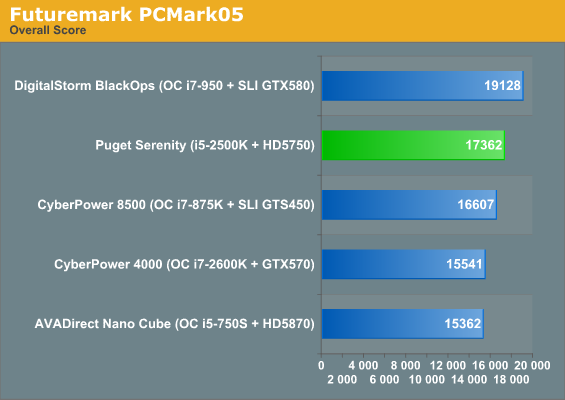
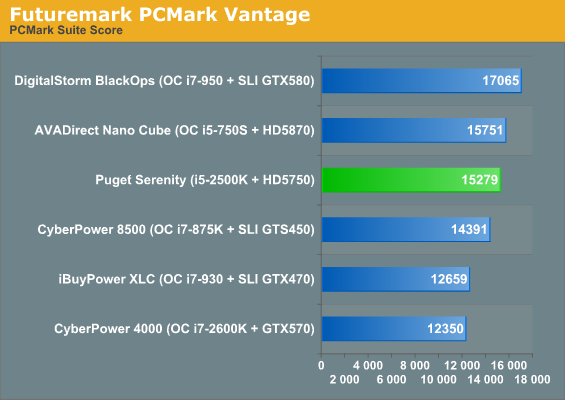
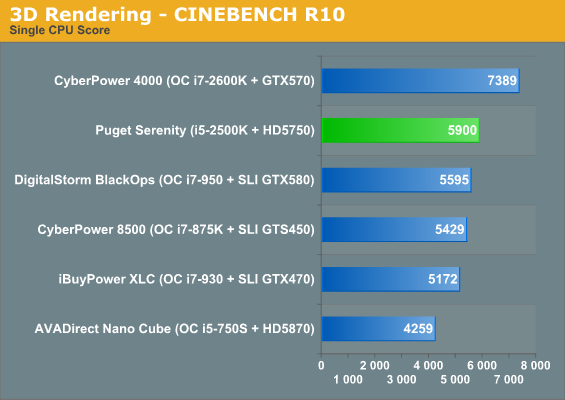
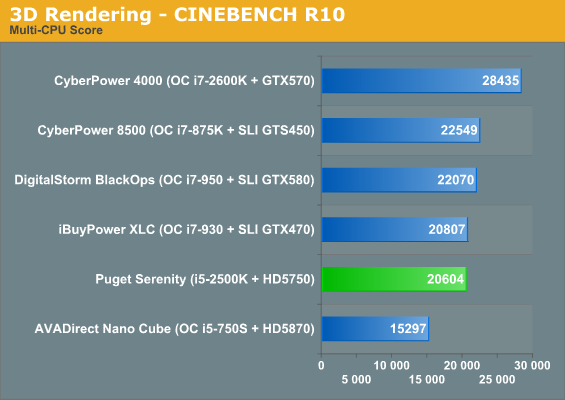
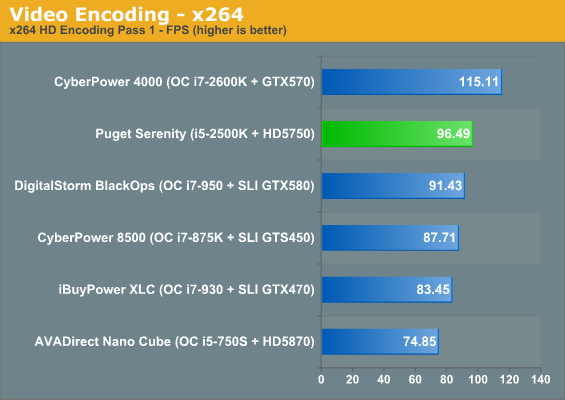

As you can see, even at stock clocks with no Hyper-Threading, it still takes a lot to hold Sandy Bridge down. The DigitalStorm and CyberPower 8500 systems are both running their processors at 3.8GHz, and DigitalStorm's tower has the added benefit of triple-channel memory. In fact the only chips that aren't Hyper-Threaded are the i5-2500K and the i5-750S, and while the i5-750S basically trails the competition here, the i5-2500K's worst showings still mostly nip at the heels of the 3.5GHz processor inside the iBuyPower XLC.
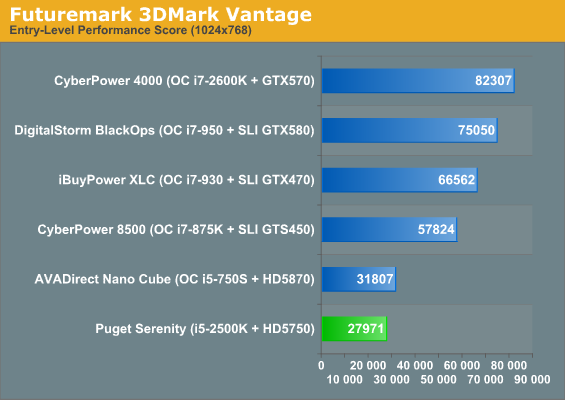
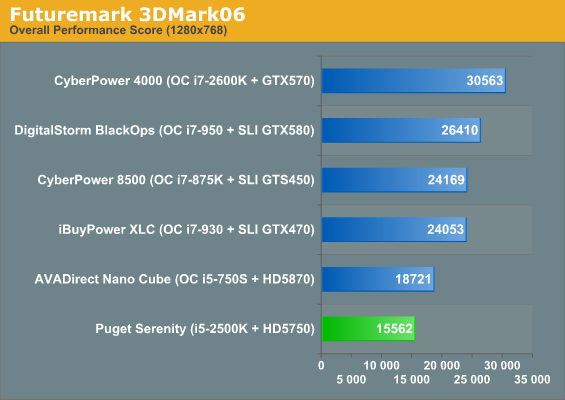

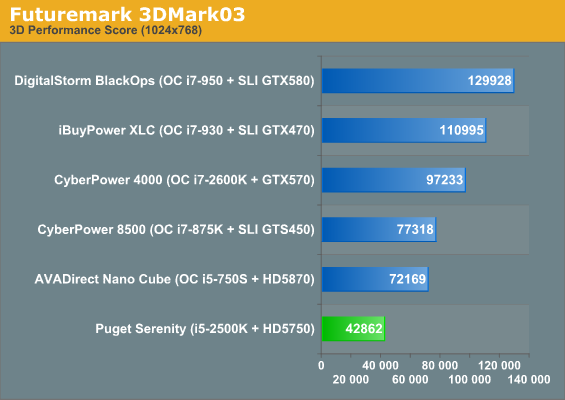
3DMark is less kind to the Puget Systems Serenity, but it still posts a strong showing and as we'll see the 5750 at its heart is for the most part able to game at 1080p. Again, remember that the Serenity is basically inaudible during gaming sessions and power consumption is remarkably low, as you'll see later. Of course, if the 5750 just doesn't cut it for you it's worth repeating that Puget Systems is working on getting a passively-cooled Radeon HD 6850 in house. It's entirely possible that by the time they can start shipping Sandy Bridge-based systems like this one again you'll actually be able to make that upgrade.










139 Comments
View All Comments
Anchen - Friday, February 11, 2011 - link
What the hell i the waste? It's not like an 850W psu draws more power, it'll only use as much as the system needs. It comes out cheaper, is effectively silent. And if you knew anything about PSU's you know you certainly don't want to continuously run at 90% of your PSU's capacity which if you were gaming with a single 6970 you would. A PSU's best efficiency is at 50% load.HangFire - Tuesday, February 22, 2011 - link
"Seasonic X-400. Game,set,match. No fan, will go up to 400watts. Whats Puget excuse?"flemeister already answered your question. They are counting on the always-on CP-850 for needed airflow. An X-400 would be silent but would only add heat to the case, not remove it.
Now... What excuse for your continued ignorance?
strikeback03 - Thursday, February 10, 2011 - link
Who called it a gaming machine? Do you think that is all Anandtech can review?michal1980 - Thursday, February 10, 2011 - link
Look at the gaming review done on this machine. Look at the author's off base, ignornant comments on 30fps. And the rant about 100-150fps. For the writer/anandtech to ever try to stretch this into a gaming machine is crap.strikeback03 - Friday, February 11, 2011 - link
I don't think they were trying to call it a gaming machine at all. They were putting it through their standard suite of tests, which includes games. This is the same as putting an Atom netbook through the standard laptop test suite, even though they know it will be producing single-digit FPS scores and is completely unsuited to that use. I did not read this article as trying to show this was any more than adequate as a gaming platform, it seemed clear to me that the point of this build is a lot of CPU power in as silent a rig as possible. Obviously if gaming is your primary use, unless you game in a crypt with sound off this probably shouldn't be how you spend $2k.Also, 16FPS was in 1 game at their Ultra preset. You could have chosen to point out the 53 FPS it scored in the chart above the one you referenced, which would be just as much of an outlier.
pcfxer - Thursday, February 10, 2011 - link
Parts cost money, but I guarantee no one on here could achieve the same thing with the amount of research and testing that has been applied to this system. Apparently people want Engineers to work for free.IBM doesn't charge you only for parts, GM/ford/etc don't charge you just for parts and your local bike shop doesn't charge for just parts. YES! Unless you have an anechoic chamber with a noise floor below 10dB and years of experience (engineering degree or two) you can achieve this.
The chamber costs money, the engineer costs money, the time costs money. DEAL WITH IT! You couldn't do better!
MeanBruce - Thursday, February 10, 2011 - link
You are right, and you are wrong! Puget should get paid for the work they have done on this PC, absolutely!!! Out of all the parlor shop groups they really seem to know what they are doing, and for those Silent Enthusiasts out there who don't want to put together a PC this is a great way to go, certified 11db is well worth the price if you haven't experienced a PC this quiet it will change your entire computing experience!! But please don't let people believe you cannot do this yourself, you can, without an enginneering degree and without a sound chamber! My loudest component was a 10db Noctua fan that I replaced with a 6db Noctua fan, 200mm case fans attenuated down to 8db, rear case fan 6db, video card fan in auto mode 1335rpm again between 8 and 10db, how do I know? Because it's quieter than my 10db fan and louder than my 6db fan! CPU cooler Noctua NH-D14, it's so large so much surface area it needs no fan 0db. Ssd 0db! You don't need a degree or have to hire an engineer to put together an sub-10db PC, if you enjoy putting a PC together just do it yourself! ;)mino - Thursday, February 10, 2011 - link
But!You would need a brain. Those are a much harder to get than degrees.
PartEleven - Friday, February 11, 2011 - link
Wait? What? SPCR's own anechoic chamber has a noise floor of 10.21 db. Even they have a hard time measuring the noise from this system.In reading your post it sounds like you are basing your own system's sound using your own subjective hearing and comparing it to a fan advertised at 10db. You fail to realize that nearly every sound rating advertised on the package of a fan is misleading at best. There's no way your system is 10db.
Taft12 - Friday, February 11, 2011 - link
Nor do sound waves exist in a vacuum in the real world. More than one fan will create a multiplying effect leading to a db measure higher than the "rating" of any single fan.